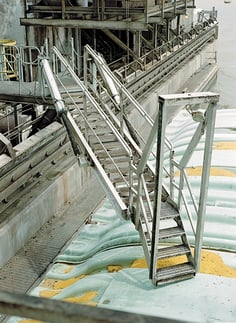 Marine safety risks affect everyone who needs to access your vessel while it’s in port, from pilots and supervisors to longshoremen. Ships are in constant motion on the water, so you must provide stable, safe access to avoid falls. Every ship gangway in use at your site must be sturdy and well secured.
Marine safety risks affect everyone who needs to access your vessel while it’s in port, from pilots and supervisors to longshoremen. Ships are in constant motion on the water, so you must provide stable, safe access to avoid falls. Every ship gangway in use at your site must be sturdy and well secured.You may already be working to meet local port and marine terminal agreements regarding fall prevention. However, are you ensuring your safety systems account for all of the risks your workers are exposed to? Consider how you can drastically improve ship gangway safety and protect your workforce.
Mitigate Common Gangway Risks
In the interest of “getting the job done,” employers sometimes let convenience take precedence over safety. For example, workers may use makeshift wooden planks to access vessels docked next to one another. Such tactics increase the risk of falling into the water, where a worker may drown.
In addition to providing safe dock gangways, use security netting underneath gangways as an extra precaution if the lower end overhangs the water. As you develop a safer work culture, take steps to mitigate the following gangway safety risks:
- Loose handrails
- Insufficient lighting
- Wet and slippery surfaces
- Unsecured gangway netting
- Poorly positioned netting
Cluttered gangways also cause trips, so be sure to practice regular housekeeping. Remove ropes, tools and other objects from gangways so everyone can access the vessel safely.
Finally, training is a challenge when your workforce includes longshoremen who aren’t employees. Longshoremen may only work for you occasionally, and some may be entirely new to your processes and safety equipment. Provide ongoing point-of-use training to ensure all workers know how to set up and use ship gangways properly.
Follow OSHA Gangway Requirements
As the expert on workplace safety, OSHA is a valuable resource in developing safer gangway practices. OSHA states that workers shouldn’t board or leave a vessel, except a barge or river towboat, until the following requirements are met:
- The gangway is maintained in safe repair
- The gangway is secured
- Each side of the gangway has a railing with a minimum height of 33 inches
- The gangway is equipped with midrails
- Rails are made of wood, pipe, chain, wire or rope and are kept taut
- Each gangway is properly trimmed
- A walkway is provided if the foot of the gangway is more than one foot away from the edge of the apron
- Supporting bridles are kept clear
- Drafts of cargo do not pass over the access point
Complying with OSHA regulations protects your business against citations and fines. More importantly, it helps to prevent dangerous falls that put your workers’ lives at risk.
A marine shipping site isn’t an inherently safe place to work. That’s why you need to take the extra initiative for your workers and build a safer work environment. Safe access equipment improves productivity and ultimately worker satisfaction.
Want more tips on improving marine safety? Learn how to protect workers and grow your bottom line.




